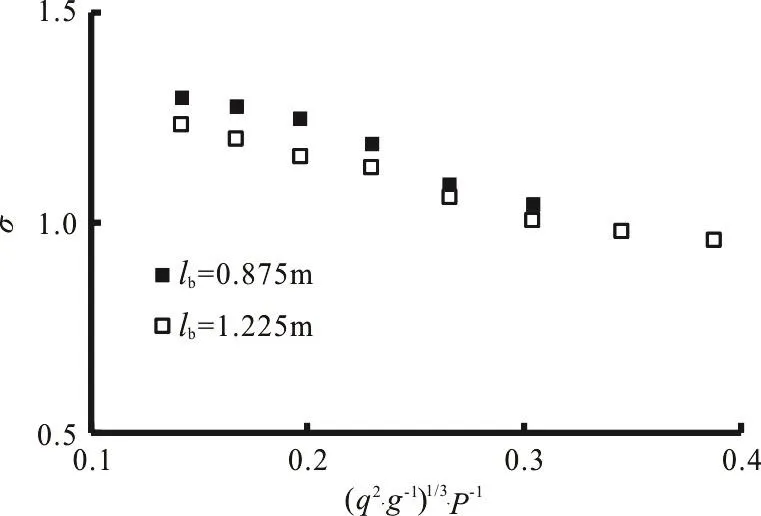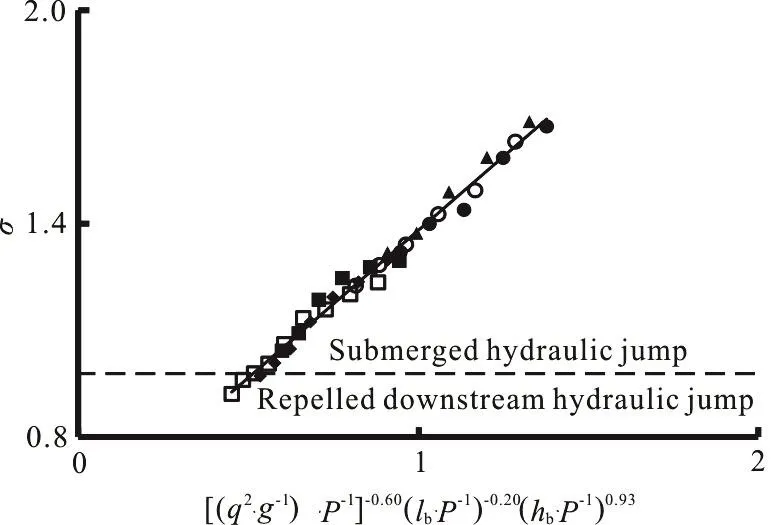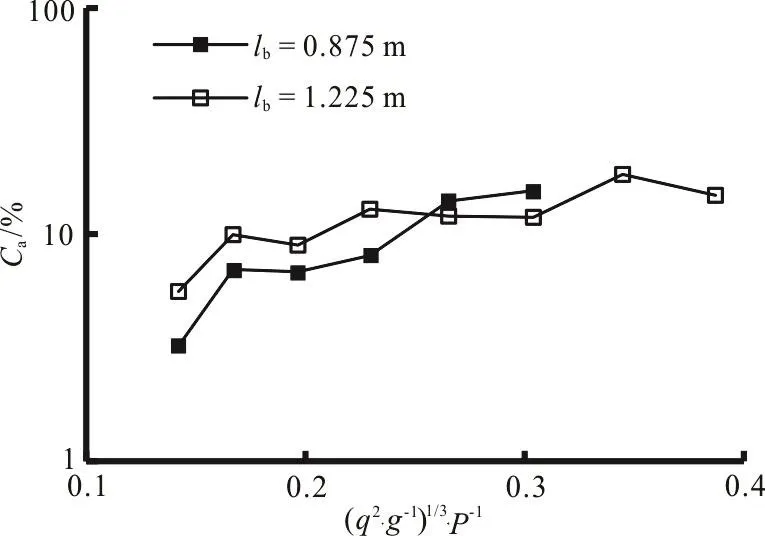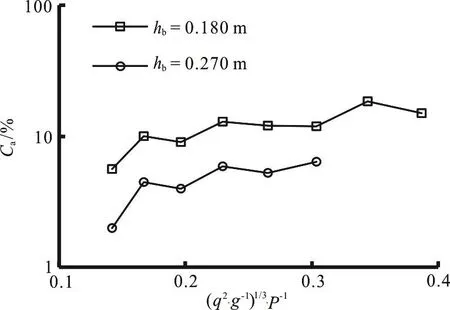Air entrainment of hydraulic jump aeration basin *
Jian-hua Wu (吴建华), Yu Zhou (周宇), Fei Ma (马飞)
College of Water Conservancy and Hydropower Engineering, Hohai University, Nanjing 210098, China
Abstract: In order to avoid the cavitation damage and the decrease of the energy dissipation of the stepped spillways with a large unit discharge, the air entrainments of the hydraulic jump aeration basin (HJAB) are theoretically and experimentally investigated for the hydraulic-jump-stepped spillway developed by the authors.It is shown that the submerged degree of the hydraulic jump and the air concentration in the measuring section are all functions of the dimensionless discharge, the length and the end sill height of the HJAB.The submerged degree σ decreases with the increase of the dimensionless discharge or the dimensionless length of the HJAB, but increases with the increase of the dimensionless height of the end sill of the HJAB.The flow regimes near the critical hydraulic jump,namely, at σ = 1.0, have the best effect of the air entrainment for the flow at the measuring section and then that of the stepped spillway.
Key words: Air entrainment, hydraulic jump, hydraulic jump aeration basin, stepped spillway, submerged degree
Stepped spillways are widely used in hydropower projects due to the simple structure and the high energy dissipation[1-2].When the unit discharge reaches or exceeds some limit, like 50-60 m2/s, we will have an insufficient air entrainment for the flow, to cause the cavitation damage and decrease the energy dissipation.Therefore, the increase of the unit discharge of the stepped spillways has been studied for recent 10 years, especially, through the pre-aeration to the flow for the stepped spillway.
The pre-aeration methods mainly involve a deflector[3], a step aerator[4], the flare gate piers[5], the aerated piers[6], and the ski-jump aeration basin[7].The first two types supply the air for the flow from the bottom of the spillway, but with the non-aerated flow regions in the sidewalls.Besides, the pre-aeration is finished through the flare gate piers, or the aerated piers, or the ski-jump aeration basin.
A hydraulic-jump-stepped spillway is developed(Fig.1)[8], to generate the aeration flow to the stepped spillway by means of the air entrainment of the hydraulic jump aeration basin (HJAB).
This paper theoretically and experimentally investigates the flow regimes in the HJAB and the air entrainment generated by the HJAB.

Fig.1 Definition sketch of flow through HJAB
Figure 1 is the definition sketch of the flow through a HJAB, including a coordinate system (xoy).The flow enters the stepped spillway in a hydraulic jump in the HJAB.In this figure,Pis the WES weir height,qis the unit discharge,His the flow depth at the weir top,lbandhbare the length and the end sill height of the HJAB, respectively,hs=hb– 0.5b,is the reverse step height,aandbare the length and the height of a single step, respectively, andhtis the sequent flow depth of the hydraulic jump.
With the increase ofq, the flow regimes in the HJAB change from the submerged hydraulic jump, to the critical hydraulic jump, and then to the repelled downstream hydraulic jump.Those changes can be described by the submerged degreeσ, i.e.[9]

whereg= 9.81 m/s2, is the acceleration of gravity, andhcis the flow depth at the contraction section for the critical hydraulic jump and can be expressed as

whereEois the upstream total head,φ= 0.95,is the velocity coefficient[10], andα≈ 1, is the velocity correction coefficient.σ= 1 means the critical hydraulic jump, andσ> 1 andσ< 1 mean the submerged and repelled downstream hydraulic jumps,respectively.
The submerged degreeσin the HJAB, the air concentrationC, and the average concentrationCaof the measuring section could be expressed as

whereρis the density of water.Consider the relationship betweenHandq[11]

Equation (3) can be rewritten as

where (q2|g)1/3|Pis the dimensionless discharge,lb|Pisthe relative length of the HJAB, andhb|Pis the relative height of the end sill.

Fig.2 Experimental setup
The experimental setup consists of a pump, an approach conduit, a large feeding basin, a test model,and a flow return system (Fig.2).The test model includes an approach flow channel, a weir, an HJAB,a stepped spillway and a tailwater channel of 0.275 m in width.P= 0.630 m, is the weir height, and its overflow surface slope is 1V: 0.67H.a= 0.11 m andb= 0.09 m, are the length and the height of the model step, respectively.

Table1 Cases and geometric parameters of HJAB
The model discharges are measured by the discharge measurement weir instruments located in the flow return system.Five air concentration probes are placed in the sidewall of the measuring section,0.01 m, 0.06 m, 0.11 m, 0.16 m and 0.21 m,respectively, away from the top surface of the end sill.The air concentration is measured by CQ6-2005 aeration apparatus[12].Table1 lists the experimental cases and geometric parameters of the HJAB based on Eq.(5).

Fig.3 Variations of σ with (q2|g)1/3|P at different lb|P
The observation of the flow regimes in the HJAB shows that, with the increase ofqfrom 0.056 m2/s to 0.377 m2/s (M31), three flow regimes occur successively in the HJAB, i.e., the submerged hydraulic jump, the critical hydraulic jump, and the repelled downstream hydraulic jump.Clearly, the air entrainment to the flow is related to the flow regimes of the different hydraulic jumps in the HJAB.
Figure 3 is the variations ofσwith (q2|g)1/3|Pat differentlb|P.σdecreases with the increase of(q2|g)1/3|P, andlb|Phas some effects onσ.σis small iflbis large at the same (q2|g)1/3|P.Figure 4 is the variations ofσwith (q2|g)1/3|Pat differenthb|P.hb|Phas significant effects onσ, and the highhb|Phas largeσat the same (q2|g)1/3|P.The case ofhb= 0.270 m produces the submerged hydraulic jump at(q2|g)1/3|P= 0.3, while, forhb= 0.180 m, the repelled downstream hydraulic jump occurs.

Fig.4 Variations of σ with (q2|g)1/3|P at different hb|P

Fig.5 Variations of σ with [(q2|g)1/3|P]-0.60(lb|P)-0.20(hb|P)0.93
Figure 5 shows the variations ofσwith its influencing factors in all cases, and the best fit is for the data from this figure (R2= 0.99)

And

Equations (6) and (7) are valid for 0.14 ≤ (q2|g)1/3|P≤0.43, 1.39 ≤lb|P≤ 1.94 and 0.29 ≤hb|P≤ 0.43.Obviously,σis a function of (q2|g)1/3|P,lb|Pandhb|P.M= 0.532 atσ= 1.0 means that the critical hydraulic jump occurs in the HJAB, while,M> 0.532 andM<0.532 are the submerged and repelled downstream hydraulic jumps, respectively.
Figure 6 is the variations ofCwithYat the measuring section in the HJAB for different values ofq(M31), whereY= (yi–hb)/(ymax–hb), is the relative position of the air concentration probe, withyiandymaxas the heights from the HJAB bottom to the probes and to the free flow surface, respectively.

Fig.6 Variations of C with Y at measuring section for different values of q (M31)

Fig.7 Variations of Ca with (q2|g)1/3|P for different values of lb|P

Fig.8 Variations of Ca with (q2|g)1/3|P for different values of hb|P
For allq, there are the approximate variations ofCwithY.Cincreases with the increase ofY, and the air is effectively entrained into the flow thanks to the effect of the hydraulic jump in the HJAB, and has a better effect of decreasing the cavitation risk for the stepped spillway[13-15].
Figure 7 is the variation ofCawith (q2|g)1/3|Pfor different values oflb|P.Caincreases with the increase of (q2|g)1/3|P, and approximately, a longerlbhas a slightly higherCathan a shorterlb.Figure 8 is the variation ofCawith (q2|g)1/3|Pfor different values ofhb|P.Clearly,hb|Phas a remarkable effect onCaand the smaller the value ofhb|P, the higher the value ofCais.

Fig.9 Variation of Ca with σ
Figure 9 is the variation ofCawithσ, where the vertical line atσ= 1.0 stands for the critical hydraulic jump.It could be noticed that the flow regimes near the critical hydraulic jump have the best effect of the air entrainment, withCastill more than 3%, althoughCa(σ) decreases forσ> 1.0.
In summary, the submerged degree (σ) of the HJAB, and the air concentrations (CandCa), are all functions of the discharge (q2|g)1/3|P, the length (lb|P)and the height of end sill (hb|P) of the HJAB.
Atσ= 1.0, namely, near the critical hydraulic jump, the flow regimes have the best effect of the air entrainment for the flows at the measuring section and then for that of the stepped spillway.
- 水动力学研究与进展 B辑的其它文章
- Call For Papers The 3rd International Symposium of Cavitation and Multiphase Flow
- Improving the real-time probabilistic channel flood forecasting by incorporating the uncertainty of inflow using the particle filter *
- A selected review of vortex identification methods with applications *
- Tracer advection in an idealised river bend with groynes *
- Simulation of the overtaking maneuver between two ships using the non-linear maneuvering model *
- The effect of downstream resistance on flow diverter treatment of a cerebral aneurysm at a bifurcation: A joint computational-experimental study *

